 Like a lot of kids, I went through a phase growing up where I was obsessed with trains and rail travel. As a kid in California, we spent a good chunk of our elementary school social studies classes on the role of railroads - namely, the US Transcontinental Railroad on the development of the American West. Later, living in Taiwan throughout my teenage years, I raked up god knows how many miles riding on Taiwan Railway Administration (TRA) trains and later on, aboard the MRT and now the High Speed Rail. Railways were cool. On holidays I'd hop a cheap local train and end up a few hours later in some random city or town ready for a couple hours of wandering around gawking at the local sights. When I got tired of it, I'd head back to the station and hop on the next train back to Taipei. As much as I enjoyed bitching about the surly blue collar nature of TRA, the hilarious Chinglish signage, and how my last train was all of 5 minutes late, the TRA was sort of my ticket to adventures (if you can call them that) outside the hordes of people in the city, and at the same time, sort of a safety line. Who cares if Chongde Station is in the middle of nowhere when I can just hop on the next local train out in about half an hour and get back to Taipei for under US$5?
Like a lot of kids, I went through a phase growing up where I was obsessed with trains and rail travel. As a kid in California, we spent a good chunk of our elementary school social studies classes on the role of railroads - namely, the US Transcontinental Railroad on the development of the American West. Later, living in Taiwan throughout my teenage years, I raked up god knows how many miles riding on Taiwan Railway Administration (TRA) trains and later on, aboard the MRT and now the High Speed Rail. Railways were cool. On holidays I'd hop a cheap local train and end up a few hours later in some random city or town ready for a couple hours of wandering around gawking at the local sights. When I got tired of it, I'd head back to the station and hop on the next train back to Taipei. As much as I enjoyed bitching about the surly blue collar nature of TRA, the hilarious Chinglish signage, and how my last train was all of 5 minutes late, the TRA was sort of my ticket to adventures (if you can call them that) outside the hordes of people in the city, and at the same time, sort of a safety line. Who cares if Chongde Station is in the middle of nowhere when I can just hop on the next local train out in about half an hour and get back to Taipei for under US$5?Imagine my horror then, the first time I took an Amtrak train (the Coast Starlight) in California as a college student back in 2001.
I can overlook the fact that for most routes outside the Northeast Corridor, it generally isn't practical to run more than one train a day. And to be fair, the onboard service I experienced was quite good, the dining car food excellent, and the cars clean and well maintained.
"Fearful that losses from passenger service would contribute to the weakening of other railroads, policymakers looked for a way to relieve the freight railroads of that burden. The result was the passage of the Rail Passenger Service Act of 1970, which created Amtrak. The company began operating on May 1, 1971." -- The Past and Future of U.S. Passenger Rail Service, Congressional Budget Office, 9/2003. Ch. 2: A Brief History of Amtrak
None of that makes up for the fact however, that we were eight hours late pulling into San Jose.
"Once one of the most popular train lines in the world, the Coast Starlight is in jeopardy because it consistently runs five to 15 hours late due to neglect by Amtrak and the Union Pacific Railroad, said Gerald Cauthen, president of the Train Riders Association of California... the Coast Starlight has delivered only 2 percent of its passengers to their destinations on time since October of last year." -- San Francisco Chronicle, 8/8/2006
Kind of sad, considering that the US passenger rail system was once one of the best in the world... fifty some odd years ago. For intercity travel these days, it's generally a toss up between driving yourself for hours, or flying. Now, I like airplanes as much as the next aerospace engineer, but frankly for domestic travel, I think they are way too overused. I've heard it argued that massive federal subsidies for the airline industry and the interstate highway system create an environment favoring cars and planes as a one size fits all solution as far as transportation is concerned. Certainly cars and planes have their place, but sometimes it does seem like they dominate excessively here in the US due to an artificial scarcity of other options.
But let's be fair here, west of Chicago, using Amtrak is virtually unheard of. Plane tickets cost about the same as intercity rail tickets. Reasonable people fly or drive.
When it comes to traveling though, I am not a reasonable person. :D
"Today, having received a total of about $27 billion in federal subsidies over 32 years, Amtrak is still teetering on the edge of bankruptcy, and policymakers are still struggling to find a workable plan for intercity passenger rail." -- The Past and Future of U.S. Passenger Rail Service, Congressional Budget Office, 9/2003. Ch. 2: A Brief History of Amtrak
It's 5:50 AM in Downtown Denver, Colorado. The streets are still mostly empty as I step off the RTD B bus. The air is cool, but there are already signs of the dry noontime heat that is yet to come.

Like most major train stations in American cities, Union Station Denver is located near the heart of downtown. Built in the late 19th century before automobiles became commonplace, and the urban exodus that ensued, railroad passengers are spared a long drive from airports located in the outskirts of the city.

The waiting room is large, spacious, and evocative of another era. Rows of tall backed wooden benches line the interior. Only one of the four ticket counters is still operational, manned by a single lady in an Amtrak uniform. Though renovated and clean, there is still a sense of a place whose best days have passed. Though generally well maintained, most everything in Union Station looks old and somewhat worn.
The waiting room is mostly empty this time of morning, aside for a few passengers who still insist on taking the Los Angeles bound Southwest Chief. There are no security checks. No long lines. Just a quick direction from the ticket counter to wait outside for the connecting bus to arrive.
The waiting room is mostly empty this time of morning, aside for a few passengers who still insist on taking the Los Angeles bound Southwest Chief. There are no security checks. No long lines. Just a quick direction from the ticket counter to wait outside for the connecting bus to arrive.

The only long distance service from Denver is run by Amtrak. The only train that actually stops at Denver is the California Zephyr (Chicago, IL - Emeryville, CA), with one train in either direction per day. Other connections can only be made by chartered busses. The small number of trains on Amtrak's western long distance routes makes train to train transfers difficult. The first leg of my journey to Los Angeles is actually not by train but by a bus to Raton, New Mexico, where I will catch the Southwest Chief at it's 10:50AM stop there.
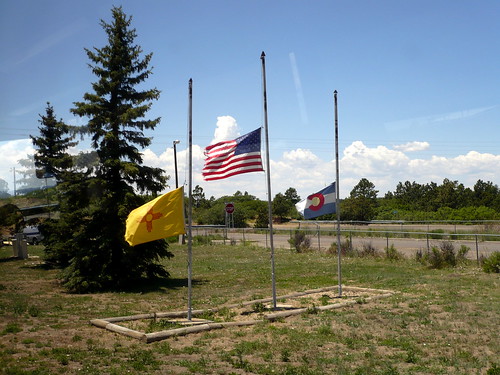
Four hours after boarding the connecting bus from Denver, I wake up was we cross the Colorado-New Mexico state line at the Raton Pass. We've gone south from Denver on I-25 and picked up more people at Colorado Springs, Pueblo, and Trinidad. The driver is a middle aged gentleman who cheerfully instructs us in the use of the bus's bathroom doorknob, which evokes a few laughs. The passengers keep mostly to themselves as we roll along and the ride is mostly silent except for a mother and two children behind me who are playing a "Guess the person" game. I am pleasantly surprised that one of the kids actually knows who Eleanor Roosevelt is.
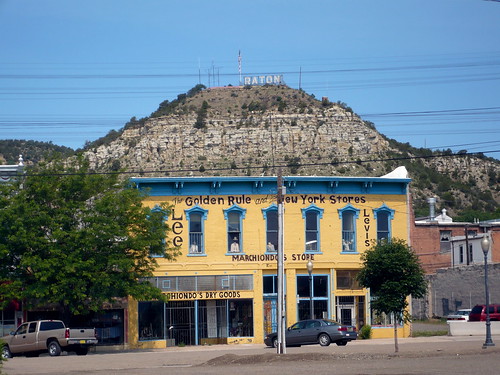

Racing ahead of the train on the railroad tracks below us, the bus drives into the town of Raton, New Mexico, population 7282 at the last census. The town is quintessentially Small Town America, with most businesses and small shops clustering around a single Main Street. We pass hardware stores and a small movie theater that looks like it was taken out of a Norman Rockwell painting.
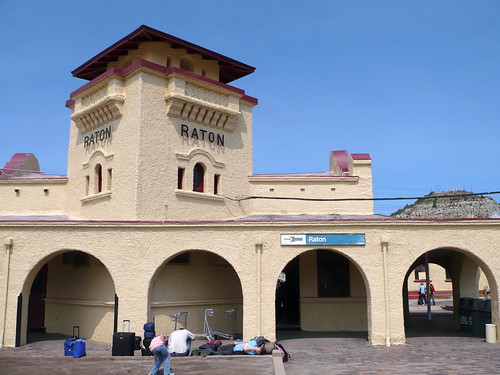
The Raton train station is a small building, built in the whole mission style that seems to be so popular in the Southwest. The station seems to be shared between Amtrak and the BNSF Railroad (freight). It's not much to look at but is the main transfer point for Los Angeles bound Amtrak passengers from Colorado.
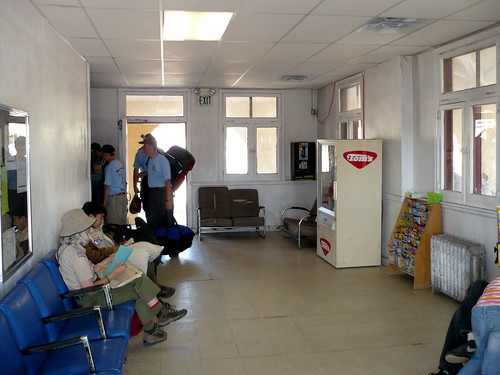
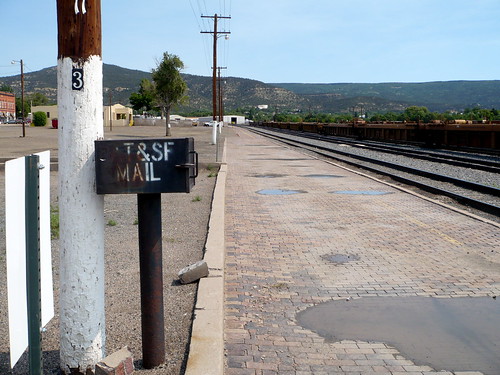
Half of the station seems to be occupied by a small waiting room. The aged look is even more apparent here, with a vending machine that looks like it was manufactured in the 60s, and separate hot and cold water taps in the restroom faucets. The actual Amtrak ticket office is actually located in a temporary prefab building outside the station itself.
Nonetheless, there seems to be quite a bit of passenger activity here, most of it being a troupe of boy scouts headed back to Albuquerque after some type of camping trip.
Nonetheless, there seems to be quite a bit of passenger activity here, most of it being a troupe of boy scouts headed back to Albuquerque after some type of camping trip.

We finally hear the train whistle and see the train itself as it rounds the bend just before the station. The Southwest Chief slowly pulls into the station as activity on the platform starts to pick up. Conductors emerge from the trains placing down yellow stools in front of the doors. I present my ticket to the conductor of a coach class car, while he checks the passenger manifest.
"LA? Okay, head on upstairs to the front of the car. There's an open reserved seat for LA right across from two young ladies on the other side of the aisle. I believe that you'll be sitting with an older gentleman to your left."
I soon learn that the conductors know virtually everyone in their designated cars... where they're going, when they want to eat, and even where they usually hang out on the train...
"LA? Okay, head on upstairs to the front of the car. There's an open reserved seat for LA right across from two young ladies on the other side of the aisle. I believe that you'll be sitting with an older gentleman to your left."
I soon learn that the conductors know virtually everyone in their designated cars... where they're going, when they want to eat, and even where they usually hang out on the train...

Our train is one of Amtrak's Superliner fleet. Though built in the late 70s and renovated in the 90s, the cars are surprisingly comfortable. Our train is comprised of (in order from the two locomotives) a checked baggage car, a sleeping car, three coach class cars, a lounge/observation car, a dining car, and another sleeper.

The coach class car that will be my home for the next 26 or so hours to Los Angeles is comprised of two rows of two seats each. Compared to typical passenger airliner seats, the train seats are heaven. Each seat is about twice as wide as an airline seat and swings backwards into a recliner like position, complete with a recliner chair like footrest.
I sit beside an elderly gentlemen who seems mostly preoccupied with his iPod. Looking around the interior of the car, I see what can only be described as a cross section of America. Adults, children, students, retirees, black people, white people... etc. I find that many people preferred to wander about the train during the day, and can rarely be found in their seats.
I sit beside an elderly gentlemen who seems mostly preoccupied with his iPod. Looking around the interior of the car, I see what can only be described as a cross section of America. Adults, children, students, retirees, black people, white people... etc. I find that many people preferred to wander about the train during the day, and can rarely be found in their seats.
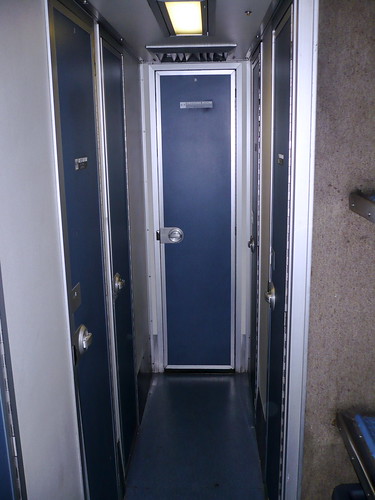
The lower level of the coach class car contains the entryway as well as four lavatories. There's also a large rack for carry on baggage and a large empty space for more cargo. Not much to say here, except that the cargo space soon became a mini campground for a group of girl scouts who spread their sleeping bags there and spent the evening hours telling ghost stories.
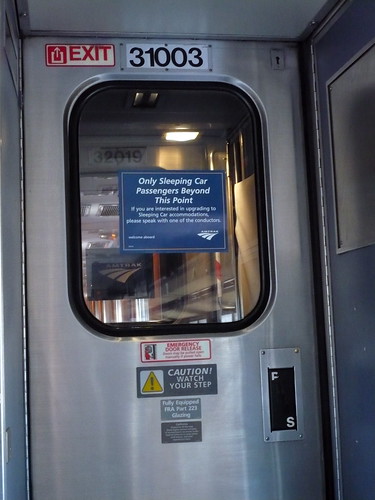
The sleepers are Amtrak's version of first class. A single sleeper compartment contains a fold down bunk above two seats and a table beside a window, all in a private compartment. The lower seats can also be converted into a second bunk. Sleeper class passengers get complementary coffee, and do not have to pay for eating in the dining car.
Very nice, but a bit pricey, especially when you're traveling alone. Besides, I found I spent most of my time in the lounge car anyhow, talking with other passengers and taking in the view.
Very nice, but a bit pricey, especially when you're traveling alone. Besides, I found I spent most of my time in the lounge car anyhow, talking with other passengers and taking in the view.
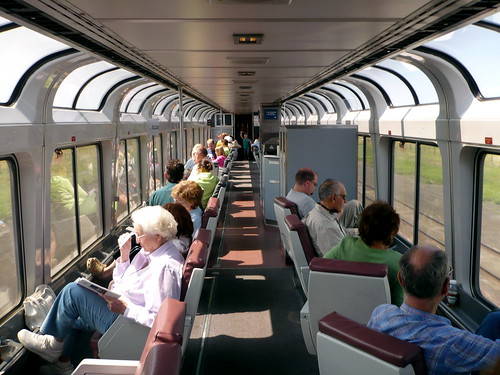
The Lounge Car is like a miniature town square, it's the center of activity for most passengers from both coach and sleeper classes. The upper level of the lounge car is a large observation room, almost always buzzing with activity and sightseers throughout the day. The single rows of seats facing the windows on either side encourage seat sharing, and indirectly, conversation between passengers.
Spending the rest of the morning in the lounge car, I talk to a couple from Pennsylvania, taking the train to Vegas ("We decided to go retro"). I ask them about the scenery so far ("Lots of grassland"). They ask me where I'm coming from ("Colorado!"), where I was originally from ("California, where all the fruits and nuts come from!"), and what I've heard about the route from my friends ("Assorted varieties of tumbleweed.")
I run into a couple from the San Fernando Valley, leading the girl scout troupe on a train trip returning from Chicago ("We always take the girls on a long train ride each year"). I make a remark about loving trains but having been burned pretty badly on my last Amtrak trip (Them: "Let me guess, Coast Starlight from LA to SF?" Me: "Yeah." Them: "Oh yes, we were late 15 hours into Seattle when we tried taking that one. The girls made us promise never to do that one again.")
Them: "You sound like you grew up in California, which part?"
Me: "Is it really that obvious?"
Them: "You said 'soda' instead of 'pop' and also used the term 'back east'."
Spending the rest of the morning in the lounge car, I talk to a couple from Pennsylvania, taking the train to Vegas ("We decided to go retro"). I ask them about the scenery so far ("Lots of grassland"). They ask me where I'm coming from ("Colorado!"), where I was originally from ("California, where all the fruits and nuts come from!"), and what I've heard about the route from my friends ("Assorted varieties of tumbleweed.")
I run into a couple from the San Fernando Valley, leading the girl scout troupe on a train trip returning from Chicago ("We always take the girls on a long train ride each year"). I make a remark about loving trains but having been burned pretty badly on my last Amtrak trip (Them: "Let me guess, Coast Starlight from LA to SF?" Me: "Yeah." Them: "Oh yes, we were late 15 hours into Seattle when we tried taking that one. The girls made us promise never to do that one again.")
Them: "You sound like you grew up in California, which part?"
Me: "Is it really that obvious?"
Them: "You said 'soda' instead of 'pop' and also used the term 'back east'."
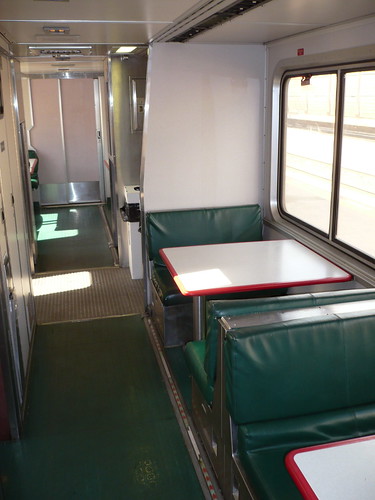
The lower level of the lounge car is designated as the "coach cafe". It's basically a simple dining area with a small convenience store like fixture where the cafe dude (for the lack of a better term) sells drinks, snacks, and microwavable meals. He also functions as a bartender, and a source of gossip and information.
This is separate from the dining car (no photos unfortunately), the next car down from the lounge car. To accommodate all the passengers who want to eat in the dinning car, the conductors periodically check through their cars asking passengers to make reservations. Parties smaller than four are also seated together.
This is separate from the dining car (no photos unfortunately), the next car down from the lounge car. To accommodate all the passengers who want to eat in the dinning car, the conductors periodically check through their cars asking passengers to make reservations. Parties smaller than four are also seated together.
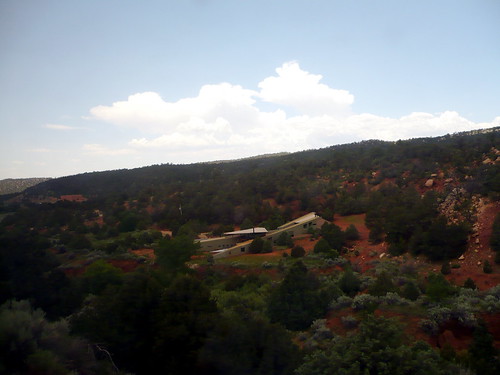
As lunchtime rolls around, I find myself seated at a table in the dining car, while we roll through a New Mexico river valley flanked by red rocks and the occasional pueblo style mansion. My tablemates are a diverse group, an Asian American civil engineer in his 30s working for a transportation consulting company in the Bay Area, returning from a trip to Oklahoma; a middle aged African American lady going home to Las Vegas; and a British lady visiting her son in Santa Fe, who opted to take the train from Denver over her son's suggestion to just fly down because she wanted to take the scenic route.
We talk about public transportation in America ("Hey, were you involved in the whole FasTracks project up in Denver?"), bemoan how sad the nation's passenger rail infrastructure has become ("... and they now serve preheated food on plastic plates. Still much better then airline food."), relay the whole General Motors streetcar conspiracy theory ("... and so GM donated busses to various cities leading to the shut down of the light rail lines we had back in the 50s..."), water problems and growth in Vegas ("...we can't keep growing at that rate, there isn't enough water"), and explain the concept of "stone fired pizza" to our British contingent ("It's a fancy way of saying oven baked").
Half way through lunch, the train pulls into Lamy station. We hear a broadcast over the intercom for someone's arriving early to pick up a passenger to Santa Fe. Our British friend excuses herself quickly scooping up the last of her stone fired pizza as we shake hands and exchange pleasantries. Then we're off again through the New Mexico countryside.
We talk about public transportation in America ("Hey, were you involved in the whole FasTracks project up in Denver?"), bemoan how sad the nation's passenger rail infrastructure has become ("... and they now serve preheated food on plastic plates. Still much better then airline food."), relay the whole General Motors streetcar conspiracy theory ("... and so GM donated busses to various cities leading to the shut down of the light rail lines we had back in the 50s..."), water problems and growth in Vegas ("...we can't keep growing at that rate, there isn't enough water"), and explain the concept of "stone fired pizza" to our British contingent ("It's a fancy way of saying oven baked").
Half way through lunch, the train pulls into Lamy station. We hear a broadcast over the intercom for someone's arriving early to pick up a passenger to Santa Fe. Our British friend excuses herself quickly scooping up the last of her stone fired pizza as we shake hands and exchange pleasantries. Then we're off again through the New Mexico countryside.
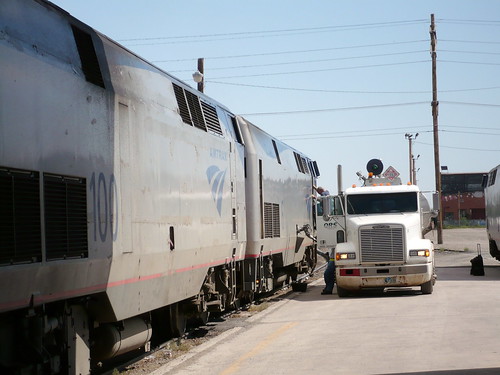
By 4PM, we've gone halfway across the State of New Mexico. The farms, small towns, river valleys, and rocky southwestern landscape have given way to residential areas, warehouses, and finally, the skyscrapers of Downtown Albuquerque come into view. The train rolls into Albuquerque Station for a 40 minute layover to refuel to locomotives. As at the other stations, the passengers are allowed onto the platform to stretch their legs.

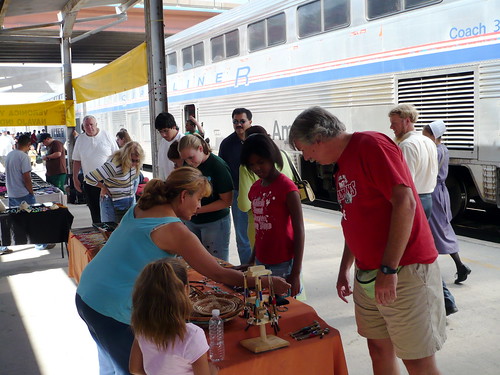
A furnace-like blast of hot air greets me as I step out of the air conditioned train onto the platform. It's 104 degrees Fahrenheit out. Almost immediately, I feel the moisture in my skin start to evaporate.
Several local Native American artists and peddlers have set up shop on the platform, hawking jewelry, blankets, and other souvenirs to the passengers. Someone mentions that there is a store in the station that sells ice cream. Judging by the crowd that immediately made for the station, I think they probably had a good business day that day. As the 40 minute time limit creeps up, everyone scrambles back aboard the train as the whistle sounds, and we start rolling again, making for the Arizona state line.
Several local Native American artists and peddlers have set up shop on the platform, hawking jewelry, blankets, and other souvenirs to the passengers. Someone mentions that there is a store in the station that sells ice cream. Judging by the crowd that immediately made for the station, I think they probably had a good business day that day. As the 40 minute time limit creeps up, everyone scrambles back aboard the train as the whistle sounds, and we start rolling again, making for the Arizona state line.

Dinnertime rolls around again. I am seated with a family of three from Missouri headed to LA for a vacation. Conversation is polite, but distant. Excusing myself at the earliest opportune moment, I make my way back to the lounge car in time to see the sun setting behind the desert horizon as we change into Arizona.
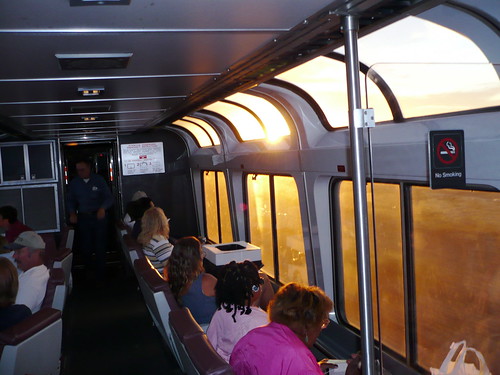
The crowd in the lounge car gradually trickles away as the sun slowly sets around 9PM. The conductor announces over the intercom that we are now on Pacific time as we cross the state line.
I find myself seated next to a young man about my age carrying a fancy looking camera. "Where are you from?", I ask. "I am from Taiwan" he says in halting English.
Me: "幹!我也是台灣人ㄟ!" ("F***! I'm also from Taiwan!")
I find myself seated next to a young man about my age carrying a fancy looking camera. "Where are you from?", I ask. "I am from Taiwan" he says in halting English.
Me: "幹!我也是台灣人ㄟ!" ("F***! I'm also from Taiwan!")
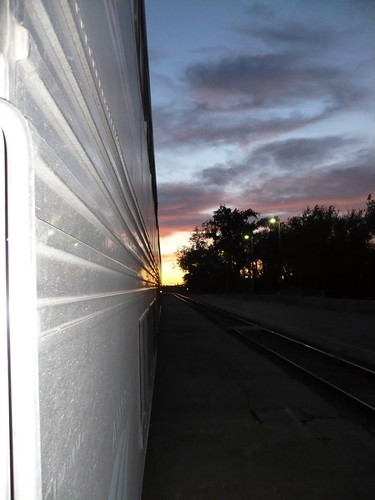
As it turns out, he was on his third month of a backpacking trip across the US that started from New York. He had spent the last two months gradually working his way across the country by rental car and train, and was planning to get off at Flagstaff, before continuing on to Los Angeles.
Me: "Don't you know anyone there?"
Him: "No, not really."
Apparently, I was the first Taiwanese person he'd seen for quite some time. After a long conversation about everything from military service in Taiwan, to US travel tips, we exchange emails before he gets off at Flagstaff.
Me: "Don't you know anyone there?"
Him: "No, not really."
Apparently, I was the first Taiwanese person he'd seen for quite some time. After a long conversation about everything from military service in Taiwan, to US travel tips, we exchange emails before he gets off at Flagstaff.

It's around 9PM when we approach Flagstaff, AZ. We experience an unexpected complication just outside the station. The train rolls to a stop just before the station, while the crew checks the engine. The station appears to be located in part of town with quite a bit of nightlife going on. Outside, we can see the lights of clubs and bars, and people who appear to be partygoers walking along the track.
While the inspection is going on, our car is stopped right smack in the middle of a railroad crossing, blocking vehicle and pedestrian traffic. Standing near the lower level entryway along with the conductor, and a few other passengers desperate to go outside for a smoke, we see some curious looking pedestrians walking up to the door and staring at us.
The conductor opens the window. A gentleman walks up to the train speaking to us in German accented English.
German dude (GD): "Wheah ah you heading?"
Conductor (C): "Los Angeles."
GD: "Wheah ah you coming from?"
C: "Chicago."
GD: "Thea ah still trains that go from Chicago to Califohnia?"
Thankfully for all involved, the train starts moving again after about 5 minutes, finally rolling into Flagstaff Station. A larger stop, we get about 10 minutes on the platform to stretch our legs and for those inclined to (as one passenger put it) "pollute their lungs".
While the inspection is going on, our car is stopped right smack in the middle of a railroad crossing, blocking vehicle and pedestrian traffic. Standing near the lower level entryway along with the conductor, and a few other passengers desperate to go outside for a smoke, we see some curious looking pedestrians walking up to the door and staring at us.
The conductor opens the window. A gentleman walks up to the train speaking to us in German accented English.
German dude (GD): "Wheah ah you heading?"
Conductor (C): "Los Angeles."
GD: "Wheah ah you coming from?"
C: "Chicago."
GD: "Thea ah still trains that go from Chicago to Califohnia?"
Thankfully for all involved, the train starts moving again after about 5 minutes, finally rolling into Flagstaff Station. A larger stop, we get about 10 minutes on the platform to stretch our legs and for those inclined to (as one passenger put it) "pollute their lungs".

I talk with the conductor while waiting for departure. A distinguished looking gentleman, I am surprised when he mentions that he is originally from Kenya, studied geology, and choose to work on the railroad for two years to see America. "I'm coming up on the two years. It's been fun, but soon it'll be time to move on to other things" he says in flawless American English.
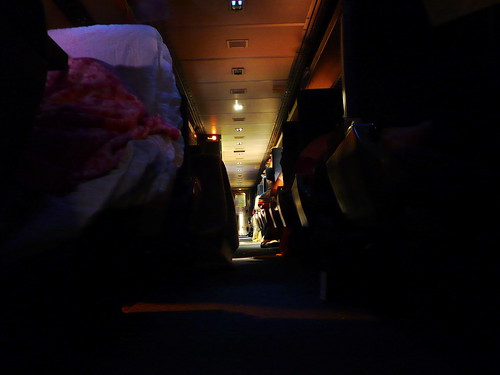
As the lights of Flagstaff fade behind us, we roll again out into the open desert. The lights dim and passengers head back to their seats and compartments to rest. I can't sleep so I head down to the cafe in the lounge car and order a beer. Unfortunately they ran out of Sam Adams, so I found myself sitting in the cafe with a can of Miller Lite.
I talk with the only other passenger in the cafe, an older looking lady eating a midnight snack. I find that she is an ESL teacher hailing from Northern California and coincidentally, her first job was teaching at the University of Colorado, where I now study.
"I loved Boulder, but couldn't stand the snow."
We talk about snow, Colorado, California, teaching ESL, the grad student life. She inquires about my research, which somehow leads to a whole new discussion on sustainable living. Finally, my beer finished, and the feeling of sleep slowly setting in, I wish her a pleasant trip back up to NorCal, and retire back to my darkened coach seat for the night.
I talk with the only other passenger in the cafe, an older looking lady eating a midnight snack. I find that she is an ESL teacher hailing from Northern California and coincidentally, her first job was teaching at the University of Colorado, where I now study.
"I loved Boulder, but couldn't stand the snow."
We talk about snow, Colorado, California, teaching ESL, the grad student life. She inquires about my research, which somehow leads to a whole new discussion on sustainable living. Finally, my beer finished, and the feeling of sleep slowly setting in, I wish her a pleasant trip back up to NorCal, and retire back to my darkened coach seat for the night.
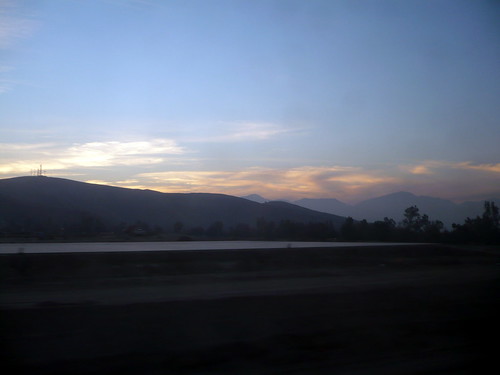
Through the night, the train passes across the deserts of Arizona and California, stopping briefly at Barstow. When I wake up to the sight of the sun slowly rising, I see a familiar sight. The rocky yellowed desert hills making way into rows of palm trees and identical looking suburban neighborhoods.
It's been three years since I left but the memories of high school and college start flooding back. Southland. Home. (Or one of the many homes for someone who moves around as much as me.) The six years I spent in SoCal seem like they happened to someone else in another life on another planet, even though it's only been 3 years. We pass through stations with names of places I remember frequenting via the tangle of freeways. San Bernardino, Fullerton...
The smoggy sky slowly brightens, and the giant megalopolis we are passing through slowly comes to life.
It's been three years since I left but the memories of high school and college start flooding back. Southland. Home. (Or one of the many homes for someone who moves around as much as me.) The six years I spent in SoCal seem like they happened to someone else in another life on another planet, even though it's only been 3 years. We pass through stations with names of places I remember frequenting via the tangle of freeways. San Bernardino, Fullerton...
The smoggy sky slowly brightens, and the giant megalopolis we are passing through slowly comes to life.
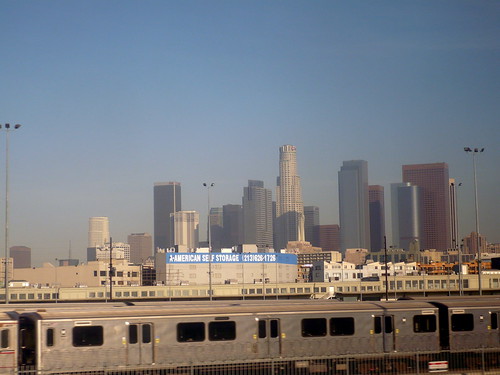
I return to my seat as we make our final approach into LA Union Station. The elderly gentleman seated next to me has finally removed the iPod headphones from his ears and nods a good morning to me as I sit down. He's coming to Los Angeles to visit his son and has taken the train all the way from Ohio.
"I normally get a sleeper but they were out this time. For a young guy like you coach is fine, but for an old man like me it's terrible."
We talk briefly about where we're coming from...
Him: "My other son is in Denver, fine city. I like it a lot more than I do LA."
Me: "LA is an acquired taste I think. I disliked it when I was living here, then hated it when I was away, but coming back to it it sorta grows on you."
"I normally get a sleeper but they were out this time. For a young guy like you coach is fine, but for an old man like me it's terrible."
We talk briefly about where we're coming from...
Him: "My other son is in Denver, fine city. I like it a lot more than I do LA."
Me: "LA is an acquired taste I think. I disliked it when I was living here, then hated it when I was away, but coming back to it it sorta grows on you."


We arrive at Los Angeles Union Station at 7:38 AM. 37 minutes ahead of schedule. This has been an interesting trip. In Taiwan, while pervasive, a train ride was an ordinary affair. You got on, sat (or stood) till you got to your stop, then got off. This ride was different. Boarding the train and mingling with the other passengers was like meeting a cross section of ordinary America. No glitz, no glamor, just ordinary people who happened to run into one another on their respective ways. We often hear people complaining about Americans being stupid, apathetic, or dense... perhaps they should consider taking a long distance train ride across America. All I can say is, for someone as pessimistic as me, this trip has gone a long way in restoring my faith in my fellow man. At heart, we are all decent people making our way through life one day at a time.
I will definitely come this way again.
Tags: [Amtrak], [Trains], [Travel],[USA]
I will definitely come this way again.
“The traveler sees what he sees, the tourist sees what he has come to see. The whole object of travel is not to set foot on foreign land; it is at last to set foot on one's own country as a foreign land.”
--G. K. Chesterton
Tags: [Amtrak], [Trains], [Travel],[USA]

2 comments:
Nice story. I love train travel as well.
I enjoyed your story very much. I'm about to take the Coast Starlight from LA to Seattle in a couple of weeks and your post gave an idea of what to expect.
Post a Comment